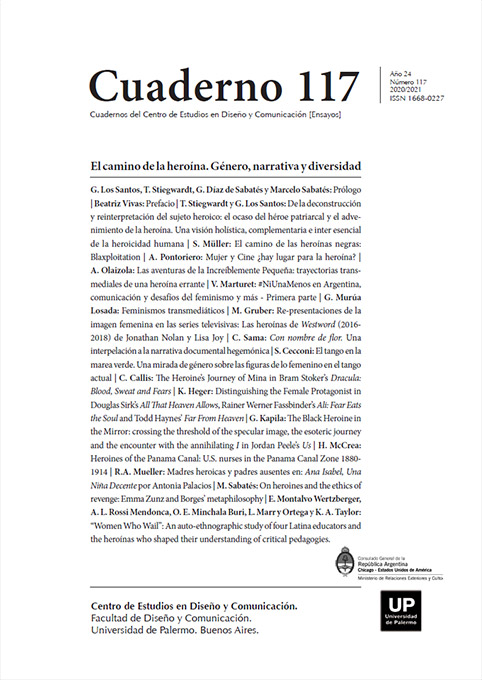Mujer y Cine ¿hay lugar para la heroína?
Abstract
When Campbell talks about the hero's path, he does it in masculine. It is naturalized that this place is occupied by a hero and not a heroine. The "path" means a structure, a series of "moments" that are repeated for every hero. We see this structure repeated over and over again in most of the stories that are told to us from the very beginning of humankind to the present. What`s interesting about Campbell's approach is that this structure is repeated at the level of the unconscious when we make the passage between childhood and our adult life. This is why all those stories, myths, that are told from one generation to another, are so deep in the consciousness of the humans that share the same culture. It´s a path full of effort and sometimes pain to seek identity, and become an adult who is usefull to society.
References
Berger, P. (1969) El dosel sagrado. Elementos para una sociología de la religión. Buenos Aires. Amorrortu.
Campbell, J. (1959) El héroe de las mil caras. México. FCE.
_________ (1991) El poder del mito. Barcelona. Emece.
_________ (2000) Los mitos en el tiempo. Buenos Aires. Emece.
Dalarum, J. (2000) La mujer a los ojos de los clérigos en Duby, G. y Perrot, M. (comp.) Historia de las Mujeres. Tomo 2. Madrid. Taurus.
Eliade, M. (1992) Mito y realidad. Barcelona. Labor.
Malosetti Costa, L. (2000) Mujeres en la frontera en Pita, Gil Lozano (comp) Historia de las Mujeres en Argentina. Madrid. Taurus.
Giunta, A. (2014) Mujeres entre activismos. Una aproximación comparativa al feminismo artístico en Argentina y Colombia en Caiana Nª 4. Revista de Historia del Arte y Cultura Visual del Centro Argentino de Investigadores de Arte recuperada en http://caiana.caia.org.ar/template/caiana.php?pag=articles/article_2.php&obj=149&vol=4 (17/02/2020)
Kratje, J. (2017) El cine como transgresión. Deseo, política y feminismo en Camila (María Luisa Bemberg, 1984) en La Trama de la Comunicación, Volumen 21 Número 1, enero a junio de 2017, p. 29 a 43.
Mulvey, L. (2007) El placer visual y el cine narrativo en Cordero Reiman, K. y Sáenz, I. (comp.) Crítica feminista en la teoría e historia del arte. México: Universidad Iberoamericana.
Rivera Garretas, M.M. (s/f) Parentesco y espiritualidad femenina en Europa. Una aportación a la historia de la subjetividad. Universitat de Barceleona recuperado en https://core.ac.uk/download/pdf/71014112.pdf (18/02/2020).
Trebisacce, C. (2013) Historias feministas desde la lente de María Luisa Bemberg en Revista Nomadías, Noviembre 2013, Número 18, p. 19-41
Los autores/as que publiquen en esta revista ceden los derechos de autor y de publicación a "Cuadernos del Centro de Estudios de Diseño y Comunicación", Aceptando el registro de su trabajo bajo una licencia de atribución de Creative Commons, que permite a terceros utilizar lo publicado siempre que de el crédito pertinente a los autores y a esta revista.


